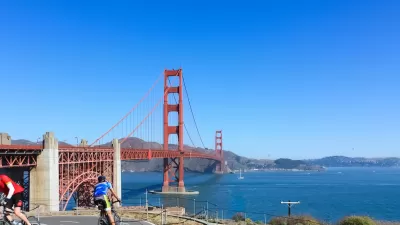The Golden Gate Bridge District is looking at ways to improve safety on the bridge's narrow, windy bike and pedestrian paths.

According to data from the Marin County Bicycle Coalition and a Golden Gate Bridge District study, "a cyclist is five times more likely to crash traversing the Golden Gate Bridge as a motorist, and 21 times more likely to be injured." This indicates the need for improved bike and pedestrian infrastructure on the famous bridge, writes Roger Rudick.
The data shows that "there were 19 times as many solo bicycle collisions as there were bicycle-pedestrian collisions," partly due to newly installed fence slats that "amplify gusts, knocking cyclists over." The Coalition "is urging cyclists to participate in an outreach program, recently launched by the Bridge District, to get feedback and more information to figure out how to reduce crashes."
"[T]he District’s study, released last year, includes some specific improvements, such as: 'install additional high visibility wind warning signage along the west sidewalk to raise awareness' and 'implement a Standard Operating Procedure to shift bicycle traffic to the east sidewalk during hazardous wind conditions.'" The MCBC's assessment "also puts partial blame on Bridge District maintenance crews that use the path as a storage area," leaving less room for bicyclists to maneuver. "We are surprised to see that the study does not make any recommendations to increase clearances for two-way bike traffic going past construction material." Streetsblog comments that "crews would never regularly store materials in a motor-vehicle lane on the bridge, certainly not without significant traffic diversions and guidance. So why is a bike path seen as a suitable place to dump stuff?"
"MCBC is asking riders of the Golden Gate Bridge to check out all their recommendations, review the District’s study, participate in the outreach program, and take the Golden Gate Bridge District poll."
FULL STORY: New Push For a Safer Golden Gate Bridge

Alabama: Trump Terminates Settlements for Black Communities Harmed By Raw Sewage
Trump deemed the landmark civil rights agreement “illegal DEI and environmental justice policy.”

Study: Maui’s Plan to Convert Vacation Rentals to Long-Term Housing Could Cause Nearly $1 Billion Economic Loss
The plan would reduce visitor accommodation by 25% resulting in 1,900 jobs lost.

Planetizen Federal Action Tracker
A weekly monitor of how Trump’s orders and actions are impacting planners and planning in America.

Wind Energy on the Rise Despite Federal Policy Reversal
The Trump administration is revoking federal support for renewable energy, but demand for new projects continues unabated.

Passengers Flock to Caltrain After Electrification
The new electric trains are running faster and more reliably, leading to strong ridership growth on the Bay Area rail system.

Texas Churches Rally Behind ‘Yes in God’s Back Yard’ Legislation
Religious leaders want the state to reduce zoning regulations to streamline leasing church-owned land to housing developers.
Urban Design for Planners 1: Software Tools
This six-course series explores essential urban design concepts using open source software and equips planners with the tools they need to participate fully in the urban design process.
Planning for Universal Design
Learn the tools for implementing Universal Design in planning regulations.
Caltrans
Smith Gee Studio
Institute for Housing and Urban Development Studies (IHS)
City of Grandview
Harvard GSD Executive Education
Toledo-Lucas County Plan Commissions
Salt Lake City
NYU Wagner Graduate School of Public Service



























